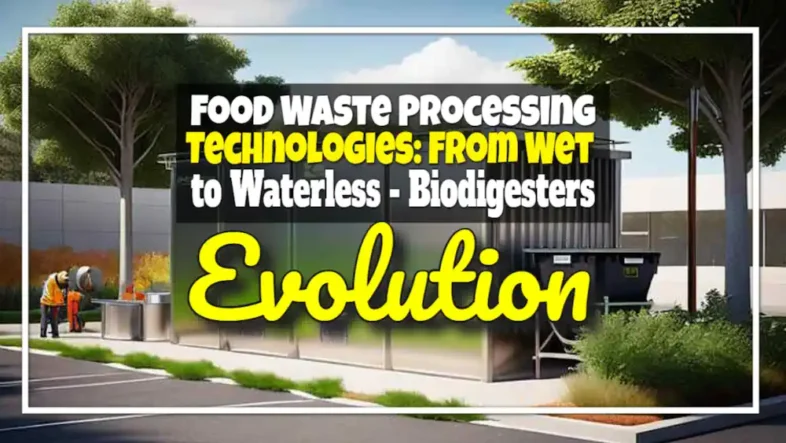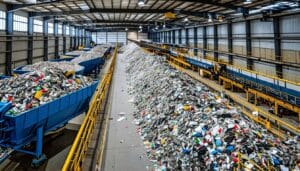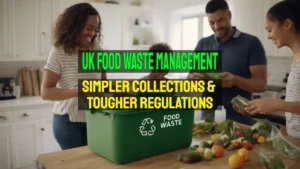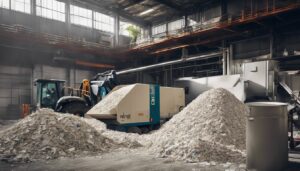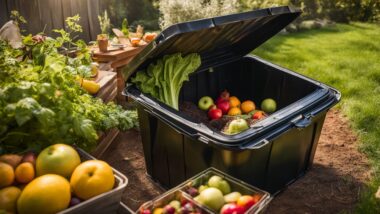Read on for the latest news on the development of wet and waterless biodigesters as a means of processing Food Waste.
As food waste management becomes an increasingly pressing issue for environmental sustainability, the evolution of waste processing technologies has been a game-changer in how we handle organic material.
For decades, the food waste processing industry has grappled with finding efficient, scalable, and environmentally friendly solutions.
From the early days of wet biodigesters and dehydrators to today’s cutting-edge waterless biodigester systems, the progression of technology is enabling decentralized, on-site food waste processing like never before.
In this article, we explore the journey of food waste processing technologies, their real-world applications, and how waterless biodigesters are transforming the industry.
Early Technologies: Wet Biodigesters and Dehydrators
Wet Biodigesters
Early innovations in food waste processing started with wet biodigesters, which have been used since the 1900s to break down organic material into a slurry that could either be treated through wastewater systems or used for agricultural purposes. While these systems allowed for the decomposition of fats, proteins, and oils, they came with several significant downsides.
One of the major issues was the volume of water required for the process, which strained local water resources. Moreover, the resulting slurry often needed to be transported over long distances for further treatment, adding to the cost and environmental footprint.
Additionally, the foul smell of the slurry made wet biodigesters unsuitable for many urban or suburban locations.

Dehydrators
In the 1980s, dehydrators emerged as another solution. These machines removed water from food waste, greatly reducing its weight and volume. However, dehydrators did not fully address the problem of food waste disposal, as the dried waste still needed to be landfilled or used as livestock feed, meaning they weren't a comprehensive solution for reducing landfill dependency.
The Shift to Waterless Biodigesters: A Technological Leap
What Are Waterless Biodigesters?
The latest innovation in food waste processing comes in the form of waterless biodigesters, which are revolutionizing how institutions handle their organic waste on-site. These systems use aerobic digestion to break down food waste into a dry, nutrient-rich material that can be used as a soil amendment or plant food.
Unlike earlier technologies, waterless biodigesters don’t rely on water for processing, meaning they avoid the water-intensive drawbacks of their predecessors. The waste reduction capabilities of waterless biodigesters are remarkable, reducing food waste volume by up to 75%, with the end product being a stable, dry solid that has a faint coffee ground-like odor.
Source: advetec.com
We understand that the rapid composting is achieved after adding a blend of bacteria and biostimulants.
- How this is truly a composting process, rather than chipping up and drying the organic material
- How the inevitable contamination in organic wastes, including plastic, is removed to avoid the concern about the negative environmental impact of the output being used as a soil amendment or plant food.
If any reader can explain please do so in the comments section below.
Why This Technology Matters
Waterless biodigesters offer several distinct advantages:
- Odor Control: Unlike wet biodigesters, waterless systems do not produce the unpleasant smells associated with food waste processing, making them ideal for use in urban environments like universities, hospitals, and corporate campuses.
- No Slurry: Without the need to transport smelly, water-heavy slurry, the logistics of managing food waste become simpler and less costly.
- On-Site Processing: Institutions can manage their waste on-site, cutting down on transportation emissions and reducing the strain on centralized waste processing facilities.
Real-World Applications: Universities, Zoos, and More
Several institutions have already embraced waterless biodigesters as part of their sustainability initiatives:
- University of San Diego: The university has been using a waterless biodigester for over two years, processing 400 pounds of food waste per day. The dry material produced is used in landscaping around campus, reducing the need for chemical fertilizers made from fossil fuels.
- Cincinnati Zoo: The Cincinnati Zoo utilizes a waterless biodigester to process food and animal waste. The nutrient-rich output is used on a local farm to grow animal feed, creating a closed-loop system that enhances sustainability.
The success of these projects demonstrates that waterless biodigesters are not just a theoretical solution but a practical one for institutions looking to cut costs, reduce their carbon footprint, and improve their sustainability practices.
Decentralized Infrastructure: Scaling Food Waste Solutions
The Power of Decentralization
As urban populations grow and centralized food waste processing facilities struggle to keep up with demand, waterless biodigesters offer an opportunity for decentralized infrastructure. Instead of relying on massive, centralized plants to process food waste, smaller institutions can now manage their organic waste on-site.
This model mimics the growing trend in energy infrastructure, where decentralized renewable energy resources like solar panels are becoming more common. By processing food waste close to where it is generated, waterless biodigesters can reduce the need for long-haul waste transportation, saving costs and reducing emissions.
Environmental and Economic Benefits
The environmental benefits of waterless biodigesters extend beyond waste reduction:
- Reduced Methane Emissions: By diverting food waste from landfills, where it would otherwise decompose and produce methane, these systems help reduce one of the most potent greenhouse gases.
- Soil Health: The nutrient-rich byproduct of waterless biodigesters can be used to enhance soil health, promoting sustainable agriculture and landscaping.
- Cost Savings: Institutions like universities, hospitals, and resorts can save significantly by processing waste on-site rather than paying for waste hauling and disposal.
Future of Waterless Biodigesters: What’s Next?
The potential for waterless biodigesters to revolutionize the food waste processing industry is vast. As more institutions and cities adopt these systems, the scaling of decentralized waste management will reduce the pressure on overburdened composting and biogas facilities.
In the future, waterless biodigesters could also be implemented at waste transfer stations or materials recovery facilities as part of a broader waste management strategy. As the technology continues to evolve, it will likely play a critical role in achieving waste reduction targets, not just in California but around the world.
Key Takeaways for Food Waste Processing Technologies
- Early food waste technologies like wet biodigesters and dehydrators paved the way but had limitations related to water use and disposal logistics.
- Waterless biodigesters represent a significant leap forward, reducing waste volume by up to 75% and producing a dry, odorless byproduct that can be used for landscaping or agriculture.
- These systems are ideal for on-site food waste processing in institutions like universities and hospitals, cutting down on waste transportation and emissions.
- The potential for decentralized infrastructure using waterless biodigesters is significant, allowing for more localized, sustainable waste management solutions.
You might also find our article about food waste interesting here.
Food Waste Processing Technologies FAQs
What is a waterless biodigester, and how does it work?
A waterless biodigester uses aerobic digestion to break down food waste into a dry, nutrient-rich material that can be used as a soil amendment. Unlike wet biodigesters, it doesn't require water and doesn't produce smelly slurry. However, it brings none of the gains in energy extraction that are available to anaerobic digestion of food waste.
Why are waterless biodigesters better than older technologies?
Waterless biodigesters have several advantages, including eliminating the need for water in the processing of food waste, reducing odor, and producing a usable, dry byproduct rather than a slurry that needs to be transported and treated.
What are the benefits of decentralized food waste processing?
Decentralized processing, such as using waterless biodigesters on-site, reduces the need for transportation of waste, cutting emissions and costs while also alleviating the burden on centralized composting and biogas facilities.
Revolutionizing Waste Recovery: Latest Separation And Sorting Innovations
Waste recovery is changing fast, thanks to new separation and sorting technology. This tech helps us sort trash better, so we can recycle more things. For example, Stadler has built a big plant in Spain for VAERSA that makes recycling easier and smarter. Keson is finding new ways to deal with old tyres, helping both […]
The Circular Economy In Fashion: Making Clothes Sustainable
Fast fashion fills our wardrobes, but most clothes end up in landfills within a year. Introducing the concept of the circular economy in fashion. It's the best hope for making our clothes sustainable. The global clothing industry creates over 92 million tonnes of waste each year, making it one of Earth's biggest polluters. A circular […]
The Future of UK Food Waste Management – Simpler Collections and Tougher Regulation
The future of UK food waste management will be a big push toward higher recycling rates through simpler collection and far greater consistency across the nations, helping citizens understand how to be green and recycle more organic waste. As the UK continues to advance its environmental goals, recently announced government policies aimed at simplifying waste […]
The Ultimate Guide To Recycling Plasterboard: How To Dispose Of Plasterboard Waste Properly
Plasterboard is a popular building material used in homes and offices. It's light, strong, and easy to work with. But when it turns into waste, we can't just throw it away like old food wrappers. Rules say plasterboard must not mix with other trash because it can harm the environment. Luckily, clean plasterboard can go […]
